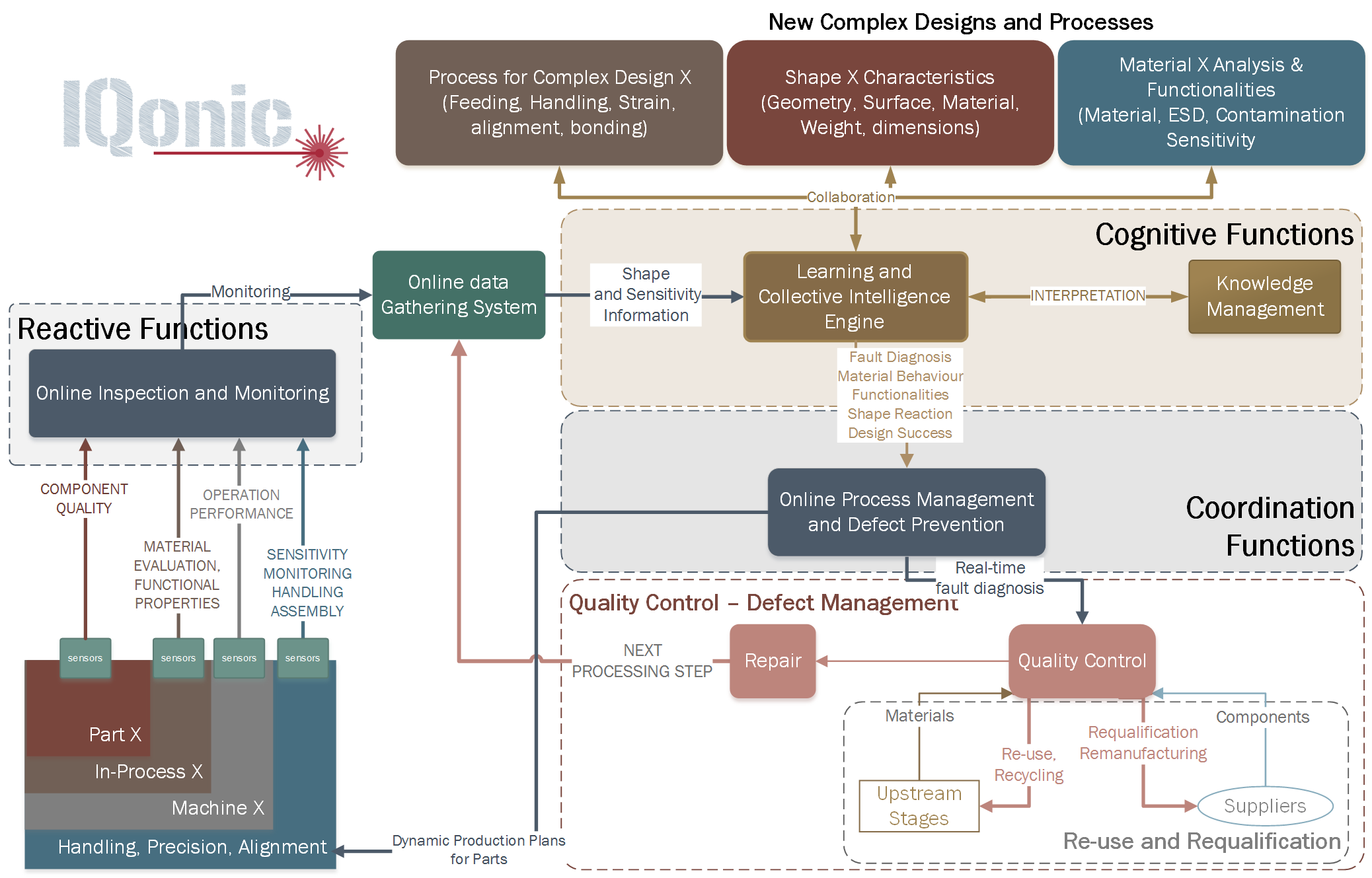
Innovative strategies, sensing and process Chains for increased Quality, re-configurability, and recyclability of Manufacturing Optolectronics
H2020-NMBP-FoF: 82067
Date: 01/10/2018
status: KO
Advances in optoelectronics technologies is causing a revolution in consumer electronic goods, solar energy, communications, LED, industrial laser, and other fields.
At present, the optoelectrical manufacturing is facing significant challenges in dealing with the evolution of the equipment, instrumentation and manufacturing processes they support. The industry is striving for higher customisation and individualisation, implying that systems configurations need to change more frequently and dynamically. IQONIC will offer a scalable zero defect manufacturing platform covering the overall process chain of optoelectrical parts. IQONIC covers the design of new optoelectrical components and their optimised process chain, their assembly process, as well as their disassembly and reintroduction into the value chain. IQONIC will therefore comprise new hardware and software components interfaced with the current facilities through internet of things and datamanagement platforms, while being orchestrated through eight (8) scalable strategies at component, work-station and shopfloor level. The IQONIC technologies will be demonstrated in 4 demo sites covering a wide range of products and processes. The impact of IQONIC to the European optoelectronics manufacturing industry, but also the society itself, can be summarised in the following (with a horizon of 4 years after project ends):
(i) increase of the in-service efficiency by 22%.
(ii) increased flexibility with 16% faster reconfiguration times.
(iii) 10% reduction in production costs through recycled components and materials.
(iv) improved designs for assembly and disassembly.
(v) about 400 new jobs created.
(vi) over 39 MEUR ROI for the consortium.
To do that we have brought together a total of seventeen (17) EU-based partners, representing both industry and academia, having ample experience in cutting-edge technologies and active presence in the EU photonics and manufacturing.
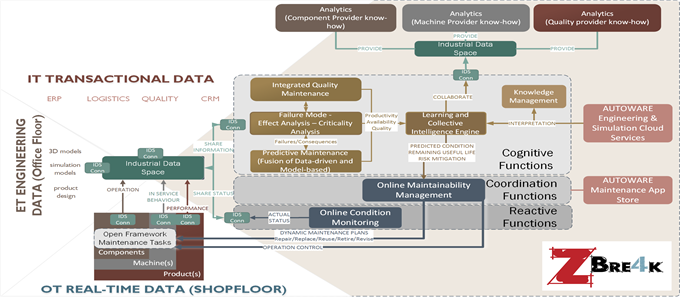
Strategies and Predictive Maintenance models wrapped around physical systems for Zero-unexpeted-Breakdowns and increased operating life of Factories (Z-BRE4K)
H2020-FOF-768869
funding: IA-Innovation action
Date: 01/11/2017
status: Commenced
Duration (months): 48
Newly built machines start their service life cycle with standard and well specified performance signatures.
Components of these machines function and work as expected and a well-defined modular maintenance (preventive maintenance) for a while would fulfil the uptime/downtime plans and schedules of the companies that utilise them. The problem arises when machines and building components, or the collective performance of the components manifesting themselves as the overall performance diminish due to depreciation. Such gradual depreciation normally leads to unexpected failures of the machine or its individual building blocks. In addition to failures, such out of norm machines produce faulty or dangerously border-line products; both causing significant costs, energy waste, as well as productivity and other efficiency shortcomings in manufacturing processes. Capitalising on the findings of the Industry 4.0 evolution, Z-Bre4k will leverage the reference architecture and operating system of the FoF11/AUTOWARE , in order to develop a highly adaptive real-time Machine (network of components) Simulation platform that wraps around the physical equipment for the purpose of predicting uptimes and breakdowns – thus creating intuitive maintenance control and management systems. This will be coupled with novel strategies and a CPPS based operating system, which when deployed in the field, are expected to increase maintainability and operating life span of production systems. The foundations will be based on the convergence of Engineering Technology (ET), Operational Technology (OT) and IT towards consolidating actionable intelligence from manufacturing assets performance modelling, for leveraging predictive maintenance for increased operating life of CPPS.
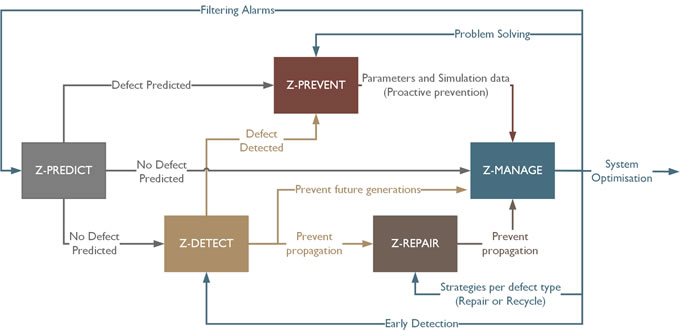
Zero-defect manufacturing strategies towards on-line production management for European factories.
H2020-FOF-723906
funding: IA-Innovation action
Date: 01/11/2016
status: Commenced
Duration (months): 42
In this project event-based adaptive control and optimisation solution to minimise defect in the discrete automated manufacturing process.
The machines and the robots will adapt to the variations in material,
customer requirements and overall environmental conditions with the purpose to reduce production defect to a minimum and eventually to zero.
Partners: Greece (CERTH and Atlantis Engineering), Cyprus (CETRI), UK (Brunel University and Microsemi), Switzerland (EPEL), Italy (Holonix, Interseals, Confindustria, and SIR), Spain (Datapixel), and Portugal (Inova, and Durit Metal Duro).

SinglX: Next Generation for Production Process Monitoring and Optimisation.
Date: 1/10/2010
status: Finalised
Sponsored by Acontrol and in collaboration with University of Coimbra.
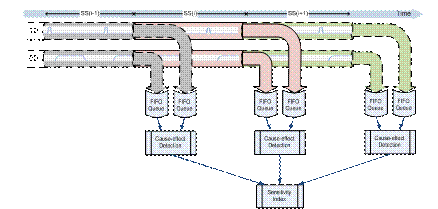
SinglX: Full R&D
funding: Sponsored by EPSRC/span>
Date: 1/2/2011
status: Finalised
Like in many other manufacturing control solution providers, existing solution for real-time decision support enjoys statistical analysis
of input data collected from a series of data entry points throughout the plant, leading to a summary of parametric performance indicators.
It seems that current shop floor performance analysis tools available in the market lack the capabilities to reduce decision making process overheads. Since they are either indicators of real time performance of the system or a simulated result of past observations. There is a need for an automatic data interpretation capability which could take pressure off managers to confidently re-schedule the production plan to improve performance and reduce cost. This research aims at proposing a generic integrated solution capable of collecting key data from shop floor control level to the higher level of MRP and ERP systems, so it could be fit to any manufacturing plant. The research will also investigate the provision of a fast forward software system to assess the trade offs between different possible scenarios within the production life cycle.
One of the outcomes of this project has been a novel real-time sensitivity analysis called EventTracker (for details please view list of publications).
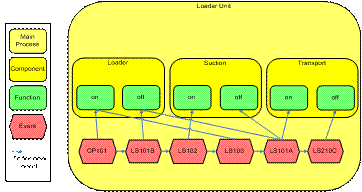
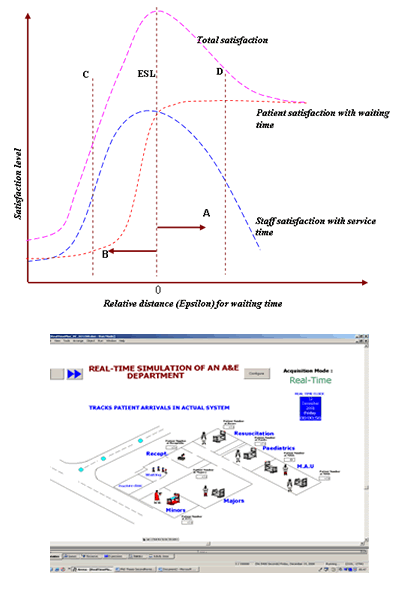
Real-Time, Knowledge-Based Decision Support System for Healthcare - The case A & E department.
funding: The North West London Hospitals NHS Trust
Date: 01/4/2009
status: Finalised
This research investigates and develops a new approach to the management of service quality with the emphasis on patient and staff satisfaction in the
healthcare sector. The challenge of measuring the quality of service in healthcare requires us to view the problem from multiple perspectives.
At the philosophical level, the true nature of quality is still debated; at the psychological level, an accurate conceptual representation is problematic;
whilst at the physical level, an accurate measurement of the concept still remains elusive to practitioners and academics. This research focuses on the problem of
quality measurement in the healthcare sector.
The contributions of this research are fourfold:
Firstly, it argues that from the technological point of view the research to date into quality of service in healthcare has not considered methods of real-time
measurement and monitoring.
This research identifies the key elements that are necessary for developing a real-time quality monitoring system for the healthcare environment.
Secondly, a unique index is proposed for the monitoring and improvement of healthcare performance using information-theoretic entropy formalism. The index is formulated based on five key performance indicators and was tested as a
Healthcare Quality Index (HQI) based on three key quality indicators of dignity, confidence and communication in an Accident and Emergency department.
Thirdly, using an M/G/1 queuing model and its underlying Little’s Law, the concept of Effective Satisfaction in healthcare has been proposed. The concept is based on a Staff-Patient Satisfaction Relation Model (S-PSRM) developed using a patient satisfaction model and an empirically tested model developed for measuring staff satisfaction with workload (service time). The argument is presented that a synergy between patient satisfaction and staff satisfaction is the key to sustainable improvement in healthcare quality.
The final contribution is the proposal of a Discrete Event Simulation ( DES ) modelling platform as a descriptive model that captures the random and stochastic nature of healthcare service provision process to prove the applicability of the proposed quality measurement models.

Survey and Satisfaction Evaluation Software System - Commercialisation Grant Awarded by WESTFOCUS.
Date: 01/07/2007
status: Finalised

Student Satisfaction Survey Initiative and Customer Optimisation Route and Evaluation (CORE).
funding: School of Engineering & Design Brunel University
Date: 17/05/2004
status: Finalised

Three dimensional Modelling of Customer Satisfaction, Retention and Loyalty for Measuring Service Performance.
Date: 01/03/2009
status: Finalised
The aim of this thesis is to propose a model that explains the relationship between customer satisfaction, retention and loyalty based on service quality
attributes. The three elements of satisfaction, retention and loyalty towards products represent ongoing challenges for the corporate
financial performance. Customer behaviour analysis (known as business intelligence or customer relationship management) has become a major
factor in the corporate decision making and strategic planning processes.
Prevailing logic dictates that by improving service attributes one should expect better customer satisfaction levels. Consequently, improved satisfaction levels should
increase the probability of customer retention and degree of loyalty. Substantial research work has been dedicated to explain the importance of customer behaviour
measurement for industry. However, there is little evidence that there has been an overall integrating empirical research that relates the three elements of satisfaction,
retention and loyalty with respect to service quality attributes. Empirical data collected from the UK mobile telecommunication for this research shows that such an objective model that is capable of capturing this three dimensional relationship will contribute towards more robust decision making and better strategic planning. The proposed thesis extracts the data about key service attributes from a combination of literature review, surveys, and interviews from the UK mobile telecommunication industry. Responses were analysed using multiple regression, regression analysis with dummy variables, logistic regression, logistic regression with
dummy variables and structural equation modelling ( SEM) to test variables and their interrelationships.
This study makes a step forward and contributes to the body of knowledge as it:
(a) highlights the role of service attribute performance towards customer satisfaction,
consequently identifies attributes that affect satisfaction and dissatisfaction of customers.
(b) maps the relationship between attribute importance and attribute performance.
(c) classifies customers with respect to the role and length of relationship they have with the company (switching probability).
(d) describes the interrelationship between customer satisfaction, retention and loyalty.
The novelty of the research lies in :
(a) establishment of a framework that links service attribute performance to customer satisfaction and then to customer future intentions (customer
retention and customer loyalty).
(b) provision of a model that could assists key decision makers in prudent usage of resources for maximum profitability.
This dissertation presents a novel approach methodology and modelling construct for customer behaviour analysis. For proof of concept it presents a case study in the mobile telecommunication industry. It is worth noting that in this research work Customer Retention is interpreted as probability of switching between service providers. Customer Loyalty is interpreted as referral (word-of-mouth) activity by existing customers.
